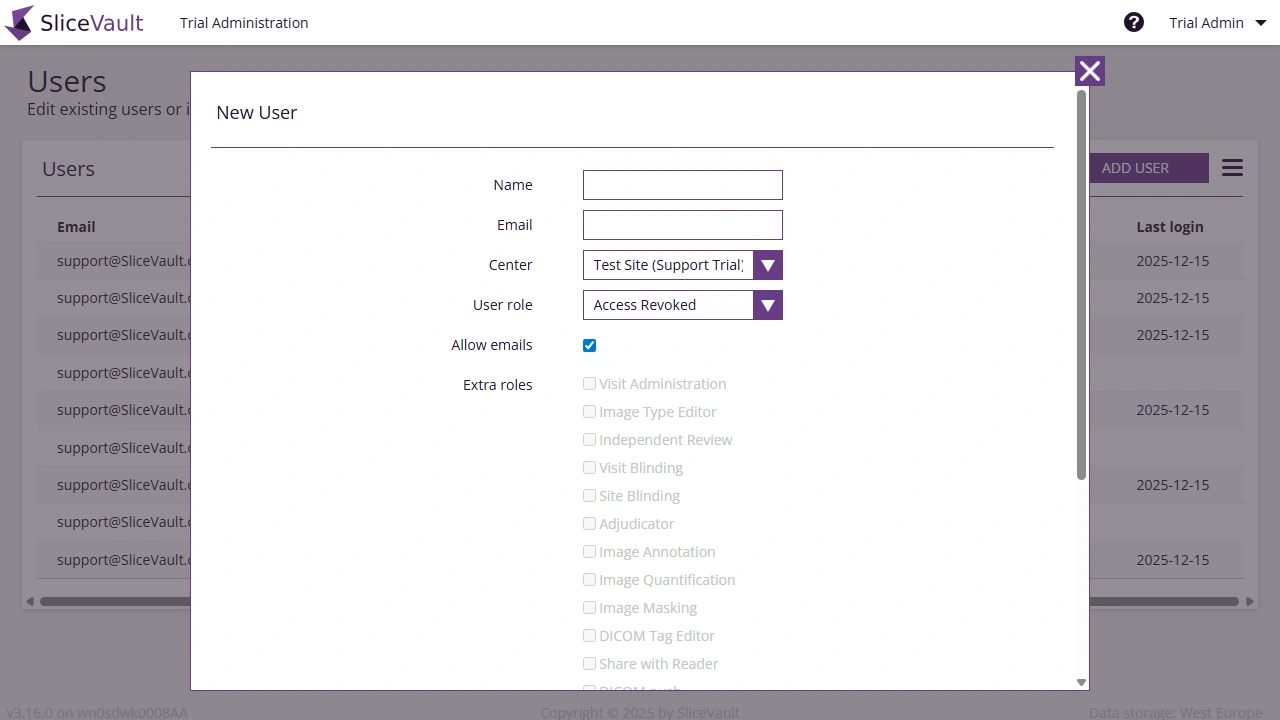Managing Users
As a Trial Administrator, you are responsible for managing user access and permissions across centers and sites. You also control which add-on features are available to specific users, ensuring the study workflow is followed correctly and securely.
Create a New User
- New users are created directly from the administration dashboard. Click Manage Users and then click Add User.

When adding a user, you enter their personal details, assign them to the correct site, and choose the role(s) that define their access. Each new user receives an automated email invitation with login credentials and instructions for accessing the system.

- Note It is important to note that the email address and the assigned center/site cannot be changed once a user is created. If either needs to be corrected later, a new account must be created.
Core User Roles
User roles define what actions a person can perform in the system. Each role reflects responsibilities within the study workflow:
Investigator
Investigators are responsible for uploading and submitting imaging data. They complete data transfer forms, manage site-specific patient records, and respond to queries raised during the study.
Quality Control Manager (QC)
QC Managers review submitted data, perform quality control checks, and manage queries. They approve or reject submissions and ensure data integrity before it proceeds to the next workflow stage.
Reader
Readers access imaging data that has passed QC, perform assessments, and record results. They may also be involved in adjudication when discrepancies between readers need to be resolved.
Trial Administrator
Trial Administrators oversee the setup and configuration of sites and users. They manage system-level settings, monitor compliance, and ensure the trial runs according to protocol.
Monitor / Project Manager
Monitors and Project Managers focus on oversight. They track compliance, ensure timelines are met, and review the progress of the study.
Assign Add-on Features
Beyond their core roles, users can be granted add-on features to extend functionality. These features enable capabilities such as DICOM tag editing, reader blinding, advanced QC support, and specialized tools for annotation and quantification.
The table below provides an overview of available add-ons and their intended use:
| Add-on Feature | Applicable To | Description |
|---|---|---|
| Adjudicator | Reader | Access to all reader assessment forms. Receives notifications when adjudication is required. Learn more |
| KPI Dashboard | Monitor, Project Manager | Access to performance metrics. Learn more |
| Share with Reader | QC 1 | Sets visit status to Pending Reader, bypassing QC 2. Learn more |
| DICOM Tag Editor | All Roles | Edit DICOM tags within uploaded images. Learn more |
| Image Masking | All Roles | Redact burned-in annotations after upload. Learn more |
| Upload Un-Redacted Data | Investigator, QC 1, QC 2 | Allow uploads without automatic redaction. Learn more |
| Site Blinding | Reader | Hide site name from the reader. Learn more |
| Visit Blinding | Reader | Hide visit name from the reader. Learn more |
| Independent Review | Reader | Multiple independent reads on the same visit. Learn more |
| Visit Administration | QC 1, QC 2 | Bypass restrictions (rename visits, move images, unlock forms, delete visits). Learn more |
| Eligibility Confirmation | All Roles | Update a patient’s eligibility status. Learn more |
| Intelligent Quality Assist | QC 1, QC 2 | Project-specific QC decision support. Learn more |
| Sync to PACS | QC 1, QC 2, Reader | Send images from SliceVault to external endpoints. Learn more |
| Image Type Editor | Investigator, QC 1, QC 2 | Change image type labels after upload. Learn more |
| Image Quantification | Reader | Access to Segmentation tools for image segmentation and quantification. Learn more |
| Data Download Disable | All Roles | Restrict users from downloading data from visit dashboard. |
| Reports Download Disable | All Roles | Restrict users from downloading reports from patient list. |
Note: By default, add-on features are restricted to their intended roles. Upon request, projects can be configured to allow all roles access to all add-ons.
Manage User Accounts
The administration dashboard provides tools for keeping accounts up to date and secure.
Password Management
- If a user forgets their password, you can trigger a reset:
-
Send password reset email to the user: Clicking this link sends the user an email with instructions to reset their password. Through this email, the user can set a new password. As part of the reset process, all previously trusted devices are cleared, requiring the user to log in again with their new credentials.
-
Get reset password link: This option is useful if the user does not receive the automatic reset email. When clicked, it provides the Trial Administrator with a direct link to the user’s password reset page. The administrator can share this link with the user via an external email. Alternatively, the Trial Administrator can use the link themselves to reset the user’s password on the user’s behalf.

Account Security
User accounts should be reviewed regularly. Trial Administrators can update roles and permissions when responsibilities change, monitor account activity, and deactivate accounts when access is no longer required. Maintaining accurate and up-to-date user information is critical for compliance and system security.